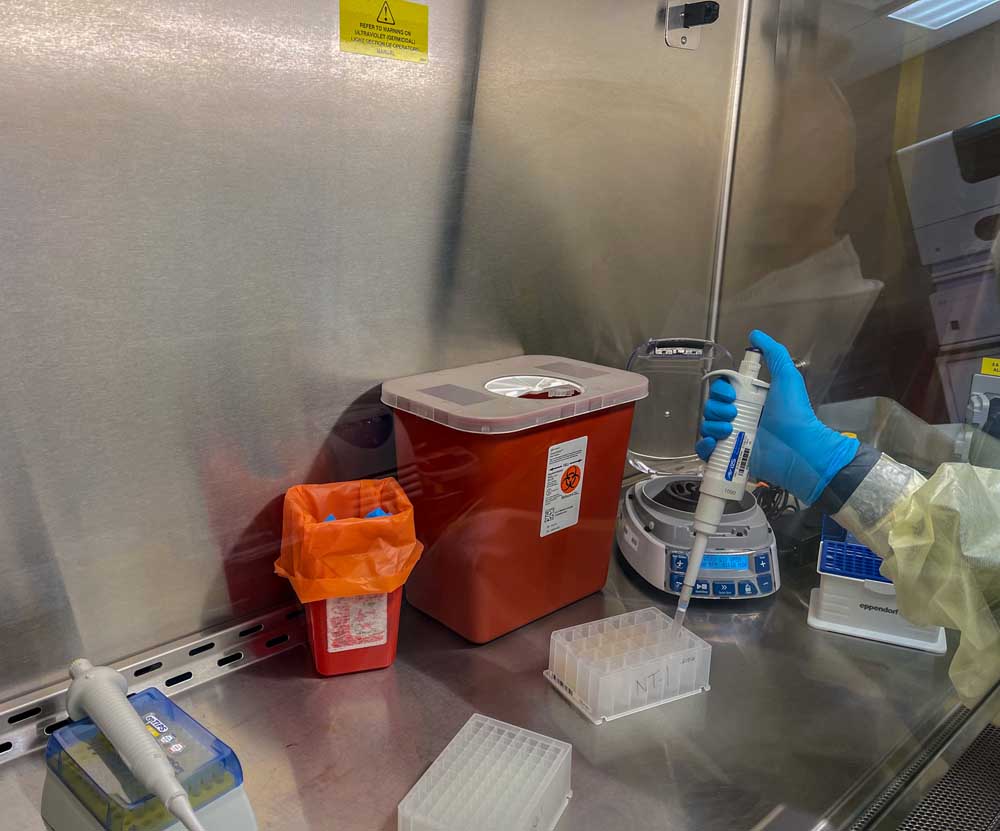Public health officials lead efforts to detect COVID-19 in East Texas wastewater
Published 5:45 am Saturday, December 18, 2021

- A member of the lab prepares initial samples for PCR testing.
Since the summer of 2020, public health labs around the nation have been working to detect COVID-19 in wastewater to monitor the spread of the virus in their communities. A group in East Texas is now localizing those efforts.
The faculty group of the UT Health Science Center in Tyler is collaborating with the Northeast Texas Public Health District and the Public Health Lab of East Texas with an ultimate goal to establish an early warning system to notify when there may be an outbreak in monitored areas.
Trending
Through the collaboration, the wastewater surveillance team has obtained permission from wastewater treatment facilities in the Tyler area, and ultimately, hope to expand to all seven counties under the NET Health jurisdiction, which also includes Gregg, Henderson, Van Zandt, Rains, Wood and Anderson counties.
Dr. Michelle Crum, assistant professor at UT Tyler Health Science Center’s school of Community and Rural Health, is the lead investigator and the originator of the idea for the Wastewater Surveillance Group for COVID-19.
“We don’t always know when we need to be tested. It can be hard to see what’s happening in the community, so this allows us to do that in a different way and look at communities in the population more as a whole, rather than in the individual level as we do with testing for COVID-19,” Crum said.
The Public Health Lab of East Texas, which was the first to give an initial response to the pandemic when it arrived in the community, was recently designated one of nine wastewater base COVID-19 centers of excellence. Along with a nanoscience company, the surveillance group has access to technology that allows an easier workflow to better detect COVID in wastewater in the laboratory.
Efforts began months ago, and as of two months ago, the group has been able to detect COVID-19 in Smith County’s wastewater.
As of now, the program does not have the ability to test for different variants of the virus, like delta or omicron, but Crum said the group is engaged in efforts to obtain the tools to do so, as genome sequencing of the virus is needed to detect those variants.
Trending
Crum explained that although they have not been able to detect omicron or delta, it’s expected omicron will replace delta because of its increased transmissibility. Crum said the expectation is it could already be present in East Texas and it not be known, as some people are asymptomatic that are the first cases.
The technical part that remains to be worked out with the detection system, Crum said, is a plan to correlate the detection of COVID in wastewater with case numbers, and how to detect it before case numbers go up. The goal is to be able to have an online dashboard, similar to NET Health’s COVID updates, with a map to detect where the virus is being found in the community.
The process
As wastewater facilities already collect samples on a daily basis for testing onsite, the Wastewater Surveillance Group for COVID-19 proposed the partnership to allow them to have a portion of the sample they take, which is a composite from a 24-hour sample. There are a number of factors that may affect the sample, such as rainwater, which can dilute the virus which may be present in the sample.
“We would like to eventually sample twice a week. Right now we’re starting by sampling once a week,” Crum said.
From there, the water is taken to the lab, where it undergoes processing, a similar-end process for PCR based testing, but separating the virus out from wastewater is different from separating the virus from, for example, a nasal swab.
Then testing is done to detect SARS-CoV-2, the virus that causes COVID-19. The information is compiled and sent to the epidemiologist on the team, Dr. Christian Alvarado, where in collaboration with students in the Masters of Public Health program, Alvarado works to begin to create maps of what they’re detecting and where from.
Crum said she hopes to eventually be able to see a map of zip codes where data is available.
“What we’re doing is, we’re looking at where do these wastewater treatment facilities receive the wastewater from, and which communities are covered by that. That ends up, eventually, becoming a display that can be seen and hopefully correlated with the current cases, which are already being reported by NET Health,” Crum said.
Crum said the department of community health and NET Health’s goal is simply to inform the community, provide resources to combat the pandemic, to have a response ready instead of responding to something that’s unexpected.
“I would want to know in my community if there was an increase in COVID-19 cases, then I might act a little differently. I might decide I’m going to wear a mask even though I’ve been vaccinated, I’m going to keep a little more distance from people, and then when I start to see that cases are starting to decrease, I might be able to adapt my behavior again,” Crum said.
Crum said the surveillance group hopes to continue to serve underserved and underprivileged communities with NET Health, especially in rural communities that may not have resources available in Tyler and in Longview.
The faculty group is also considering other factors that may affect wastewater testing, such as people who commute to the city for work and more.
“We try and look at all these factors and think about, as we see spread starting in the community, what best actions can we take to help that community before it gets to a stage where we have a lot of infections, and the healthcare system is very taxed, which has been a problem in other surges,” Crum said.





